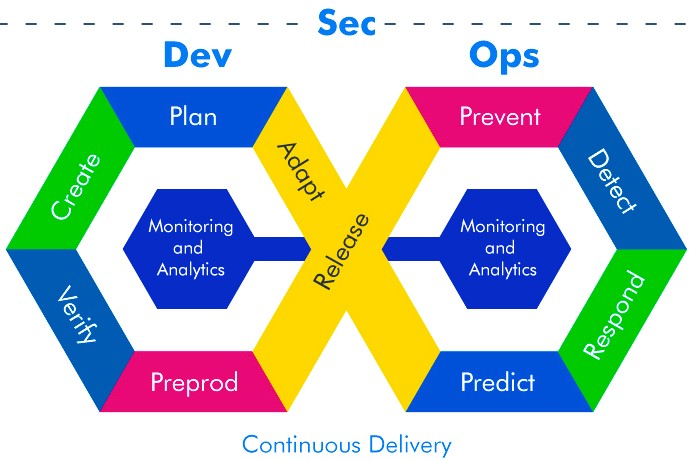The integration of Development (Dev) and Operations (Ops) into a cohesive and collaborative approach, commonly known as DevOps, has transformed the software development landscape. DevOps represents a cultural and operational shift, emphasizing communication, collaboration, and automation throughout the software development and delivery lifecycle. This article explores the evolution of DevOps, its core principles, benefits, and the role it plays in streamlining the collaboration between development and operations teams.
Understanding DevOps
1. Definition:
DevOps is a set of practices that aims to automate and improve the collaboration between software development and IT operations. It involves the adoption of cultural philosophies, practices, and tools to enhance the organization’s ability to deliver applications and services at a faster pace.
2. Key Objectives:
- Faster Delivery: DevOps aims to reduce the time taken to deliver new features, enhancements, and bug fixes.
- Reliability: It emphasizes the need for stable and reliable systems by minimizing errors and downtime.
- Scalability: DevOps practices facilitate the scalability of infrastructure and applications to meet growing demands.
- Improved Collaboration: Breaking down silos between development and operations teams promotes seamless collaboration and shared responsibilities.
Evolution of DevOps

1. Early Practices:
- In the early 2000s, software development and IT operations were often isolated, leading to communication gaps and delays in delivering software.
- Siloed structures and manual processes resulted in a lack of agility and collaboration.
2. Emergence of Agile:
- The Agile methodology emerged, emphasizing iterative development, collaboration, and customer feedback.
- While Agile addressed some collaboration issues, challenges persisted in coordinating development and operations.
3. Birth of DevOps:
- The term “DevOps” gained prominence around 2009, symbolizing a move towards greater collaboration and automation.
- DevOps aimed to bridge the gap between development and operations, fostering a shared responsibility for the entire software delivery lifecycle.
4. Cultural Shift:
- DevOps brought about a significant cultural shift, promoting a collaborative mindset and shared ownership.
- Teams started adopting practices like continuous integration, continuous delivery, and automated testing. Read our article about E-commerce Trends.
5. Continuous Integration and Continuous Delivery (CI/CD):
- CI/CD practices gained traction, automating the process of integrating code changes and delivering them to production.
- Automation reduced manual errors and accelerated the release cycle.
6. Infrastructure as Code (IaC):
- IaC became a core DevOps practice, enabling the automation and management of infrastructure through code.
- This allowed for consistent and repeatable deployments.
7. Microservices and Containerization:
- The adoption of microservices architecture and containerization (e.g., Docker) improved scalability, resource utilization, and deployment flexibility.
- Containers simplified application deployment and dependency management.
8. DevSecOps:
- Security became an integral part of DevOps with the evolution of DevSecOps.
- Security practices were integrated into the development and operations processes to ensure the continuous delivery of secure software.
9. Cloud-Native Development:
- DevOps embraced cloud-native development, leveraging cloud services to enhance scalability, flexibility, and resource efficiency.
- Cloud platforms facilitated seamless integration with CI/CD pipelines and automated scaling.
Core Principles of DevOps
1. Collaboration:
- DevOps emphasizes open communication and collaboration between development, operations, and other stakeholders.
- Cross-functional teams work together to achieve common goals.
2. Automation:
- Automation of repetitive tasks, including testing, deployment, and infrastructure provisioning, enhances efficiency and reduces errors.
- CI/CD pipelines automate the software delivery process.
3. Continuous Integration (CI):
- Developers regularly integrate code changes into a shared repository.
- CI ensures that changes are validated through automated tests, promoting early detection of issues.
4. Continuous Delivery (CD):
- Continuous Delivery extends CI by automatically deploying code changes to production or staging environments.
- This allows for the rapid and reliable release of software.
5. Monitoring and Feedback:
- Continuous monitoring provides real-time insights into application performance, security, and user experience.
- Feedback loops enable teams to iterate and improve based on user feedback and system metrics.
Benefits of DevOps
1. Accelerated Delivery:
- DevOps practices enable faster and more frequent software releases.
- Agile development and CI/CD pipelines contribute to accelerated delivery cycles.
2. Improved Collaboration:
- Collaboration between development and operations teams improves, fostering a shared sense of ownership.
- Silos are broken down, leading to better communication and understanding of each team’s needs.
3. Increased Reliability:
- Automation and standardized processes enhance the reliability and stability of systems.
- Continuous monitoring allows for proactive identification and resolution of issues.
4. Scalability:
- DevOps practices, coupled with cloud-native development, facilitate the scalability of applications and infrastructure.
- Dynamic scaling meets varying demands without manual intervention.
5. Enhanced Security:
- DevSecOps integrates security practices into the development and operations workflows.
- Security is treated as an integral part of the software delivery lifecycle.
Implementing DevOps Practices
1. Cultural Transformation:
- Foster a culture of collaboration, shared responsibility, and continuous improvement.
- Encourage open communication and a mindset shift towards automation.
2. Automation Tools:
- Adopt automation tools for CI/CD, infrastructure provisioning, and testing.
- Popular tools include Jenkins, GitLab CI, Ansible, and Terraform.
3. Cross-Functional Teams:
- Form cross-functional teams with members from development, operations, and other relevant disciplines.
- Encourage collaboration and knowledge-sharing.
4. Continuous Monitoring:
- Implement robust monitoring solutions to track application performance, security, and user experience.
- Use monitoring data for proactive issue resolution and optimization.
5. Cloud-Native Development:
- Embrace cloud-native development principles for scalability, flexibility, and resource efficiency.
- Leverage cloud services to enhance CI/CD pipelines and deployment processes.
Standards in DevOps
For those interested in exploring standards and best practices in the field of DevOps, the Wikipedia page on DevOps provides comprehensive insights. This resource covers various aspects, including the history of DevOps, key principles, practices, and notable tools, offering valuable perspectives on the standards that shape the DevOps landscape.
Challenges and Considerations

1. Organizational Resistance:
- Resistance to cultural change and the adoption of new practices can be a challenge.
- Organizations need to invest in training and change management to overcome resistance.
2. Complexity of Implementations:
- Implementing DevOps practices requires careful planning and coordination.
- Organizations must navigate the complexities of integrating automation tools and reshaping workflows.
3. Security Concerns:
- While DevSecOps addresses security concerns, organizations must remain vigilant to emerging threats.
- Regular security audits and compliance checks are essential.
4. Skill Gaps:
- Skill gaps may arise as teams transition to DevOps practices.
- Training and upskilling programs are crucial for bridging these gaps.
The Future of DevOps
The future of DevOps is likely to witness further advancements in automation, artificial intelligence, and machine learning. DevOps practices will continue to evolve, addressing emerging challenges and opportunities. The integration of observability, chaos engineering, and GitOps principles may become more prevalent, shaping the next phase of DevOps evolution.
Conclusion
The evolution of DevOps represents a transformative journey towards enhanced collaboration, automation, and efficiency in software development and operations. From breaking down silos to embracing cloud-native development, DevOps has become a cornerstone of modern software delivery practices. By adhering to core principles, leveraging automation tools, and fostering a culture of continuous improvement, organizations can navigate the complexities of DevOps and realize the benefits of streamlined development and operations.
